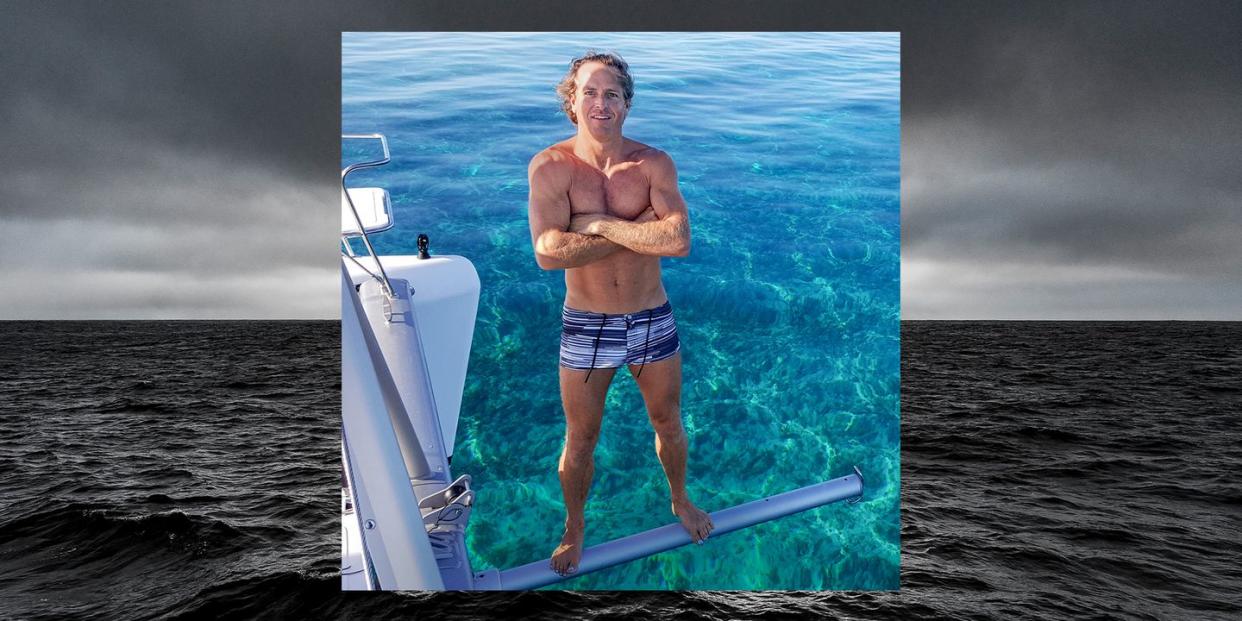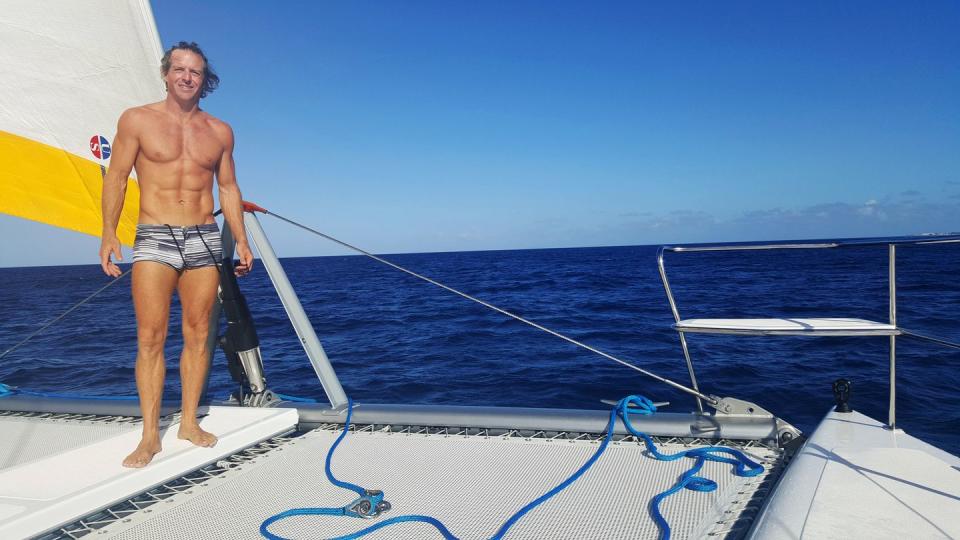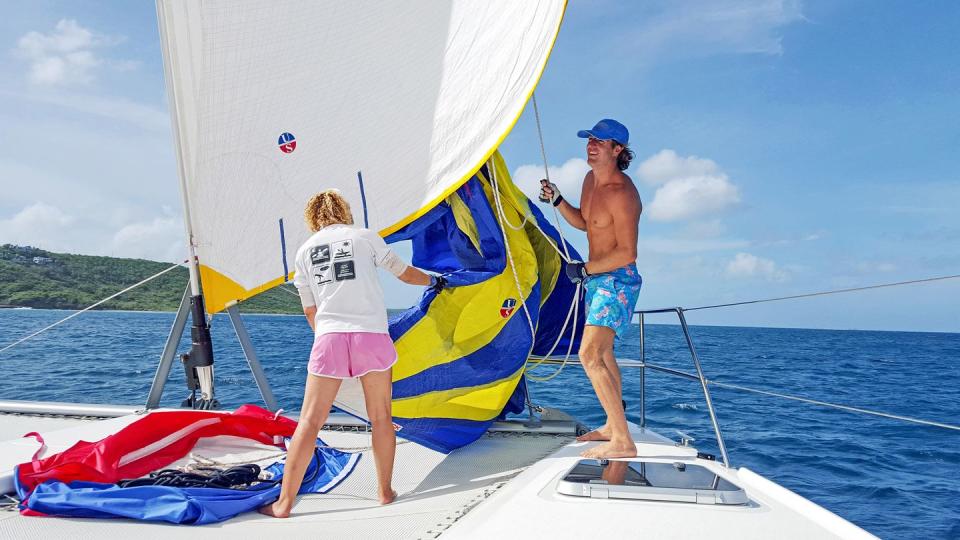My Death-Defying Year at Sea

The sounds of a ship in a storm can drive anyone mad. The wind screams through the rigging; the flapping edges of the sails boom like thunderclaps; the fiberglass hulls twist under stress, creaking and popping like joints in old age. A boat is as serene as a sleeping duck when she’s in port, but in a maelstrom, she groans and growls as if every seam were coming undone.
When I turned 40, I took a yearlong break from writing novels and built a catamaran on the southern tip of Africa, a boat that I would then take across the Atlantic and the Pacific to Fiji and beyond. It’d been my dream to sail around the world since I was young. Growing up in North Carolina, I learned to sail soon after I learned to walk, then lived on a boat while I was in college in Charleston. After my junior year, I dropped out to cruise around the Caribbean, eventually stumbling into a career as a yacht captain.

The writing was something I did in the middle, sandwiched between adventures at sea. But it was the writing that most people knew me for. I’d written a dozen novels, a few of which had done quite well. So when I sailed off from Cape Town in 2015, it seemed out of character to many. A midlife crisis, perhaps. An act of someone burned out from book tours and two or three novels a year. Those who knew me best knew the truth: I was leaving because I could finally afford to. Privately, I knew something else: I couldn’t afford not to.
Sailors invariably get asked about the storms. No one ever asks, “Did you swim with whales out there?” Or “Is there any place still untouched by man?”
They want to know about the waves. The big ones.
They want to know if their own fears of the deepest blue are founded or not. Here’s the truth: It can get scary out there, especially if you go alone. I’ve spent years at sea with no other soul aboard. If I’d fallen overboard, it would’ve been to my certain death. The boat would simply sail over the horizon without me while I treaded water until my limbs gave out or the heat seeped from my bones.
Sailing alone on long voyages is like living on the tip of a butte in the middle of the desert. Every edge of the boat is a cliff over which you’ll fall to your death. The only semblance of a railing on mine is a stainless-steel lifeline the thickness of a pencil that runs the perimeter. Smart sailors wear a harness and strap themselves to the boat when they’re at sea, even if someone is sleeping down below.

But no one ever accused me of being smart. So in the middle of the biggest, most violent storm I encountered on my voyage, I found myself inching toward the pointy tip of my starboard hull, with an eight-foot boat hook in one hand, a white-knuckled grip on that pencil-thin lifeline with the other.
Both mesh “trampolines” at the bow of the catamaran had been torn apart by the pounding of the waves. And a rope from one of them, with a massive shackle on the end, was in the water and pounding against the hull. These are the kinds of noises that drive a sailor insane. Hour after hour of BANG CRACK BOOM.
It was pitch-black. At night, all the scary things at sea become even more terrifying. You can’t see the waves, so they feel bigger. All you get is a lurch in your gut as they lift you up, slam you down, jostle you sideways. There’s a mad hiss as heavy wind lashes the sides of the boat. Up in the dark rigging, anything could be falling apart (and probably is).
In nothing but a bathing suit, I clung with a single hand and jabbed that boat hook into the void, hoping to come up with the loose line. As the boat dived into every wave, the ocean came up to my waist, the foam to my neck, the deck slick as oil.
Ten or 15 jabs . . . and finally the hook came up with the line and shackle. I tied them off and half-crawled, half-surfed back to the cockpit. It’s a moment I travel back to in my mind often, always wondering what I was thinking, out there alone, at night, hundreds of miles from civilization. I’m more terrified recalling that storm than I was in the moment. My mind can’t compute my thought process at the time. Like legs that are wobbly when we get back to land, our sea brain does something similar, taking its sweet time to readjust.
I also get asked what it’s like sailing the open sea, and the truth is that it’s mostly calm. In many ways, it’s like middle age. The things that frightened you from the shore are not the things that’ll get you. It’s the loneliness that’ll wear you down. It’s the terror of all the things you’ve left undone and unsaid. The edges of the sea are the real dangers, just as in life. The true challenge is making it out of the first few years, which are the most treacherous; on the other side, the iron reef of old age claims us all.

Out in the middle, it might be scary, but that’s where life is truly lived. Our minds find all that we’ve learned can be put to use, and our bodies gain an extra reserve of strength. I remember when my father turned 40—his birthday of gag gifts and cruel jokes was more like a funeral for his youth than a celebration of his age. But he could still turn me into a pretzel whenever he wanted. I saw the gray, the wrinkles, the slowness with which he straightened up in the morning. But I also felt his raw strength. I heard his tired voice dispense wisdom. I watched his wrinkled and weathered hands fix anything they touched.
Here’s the irony about sailing vast distances and middle age both: The safest bit is also the scariest. Out there in the middle, you expect nothing but tall seas and terrible storms. Maybe this expectation is why we are the least happy
in the middle of our lives.
Mountains of research about happiness keep turning up the same odd result: It’s a curve on a graph that dips down toward our 40s before rising back up through old age. The happiness curve, they call it. We are the most joyous at the edges, near the shore. Our unease seems to reach a trough around 47 (on average) before heading up, up, up through our 50s, 60s, and 70s. The shape of this happiness curve looks like a smile. But happiness doesn’t necessarily correlate with well-being. In my time at sea, I learned it’s what we fear that we should sail toward and through.
This article appeared in the March 2023 issue of Esquire
subscribe
“Is it scary out there?” everyone asks. “Were you afraid?”
“No,” I lie to them. I tell them about the sunsets and the times I swam with whales. I tell them about the day a pod of dolphins played seaweed keep-away with me for hours. I tell them about the remotest islands, where you want to put down anchor forever.
The scariest part of sailing across a wide ocean is the day we leave the dock. Middle age is the deep sea we dread that only becomes a storm because we turn it into one. We brace for it, but the best in life awaits us there. This has become my compass: The thing I fear is the place to steer for. All good things lie on the other side.
We are all ships at sea, in the dark, beset by storms. But what we were told would be a storm to weather is just the dip of the smile. It’s all upside from there. Ask the sociologists who measure these things. Better yet, ask anyone with a weathered face and wise eyes, whose ship is nearing that far shore.
You Might Also Like